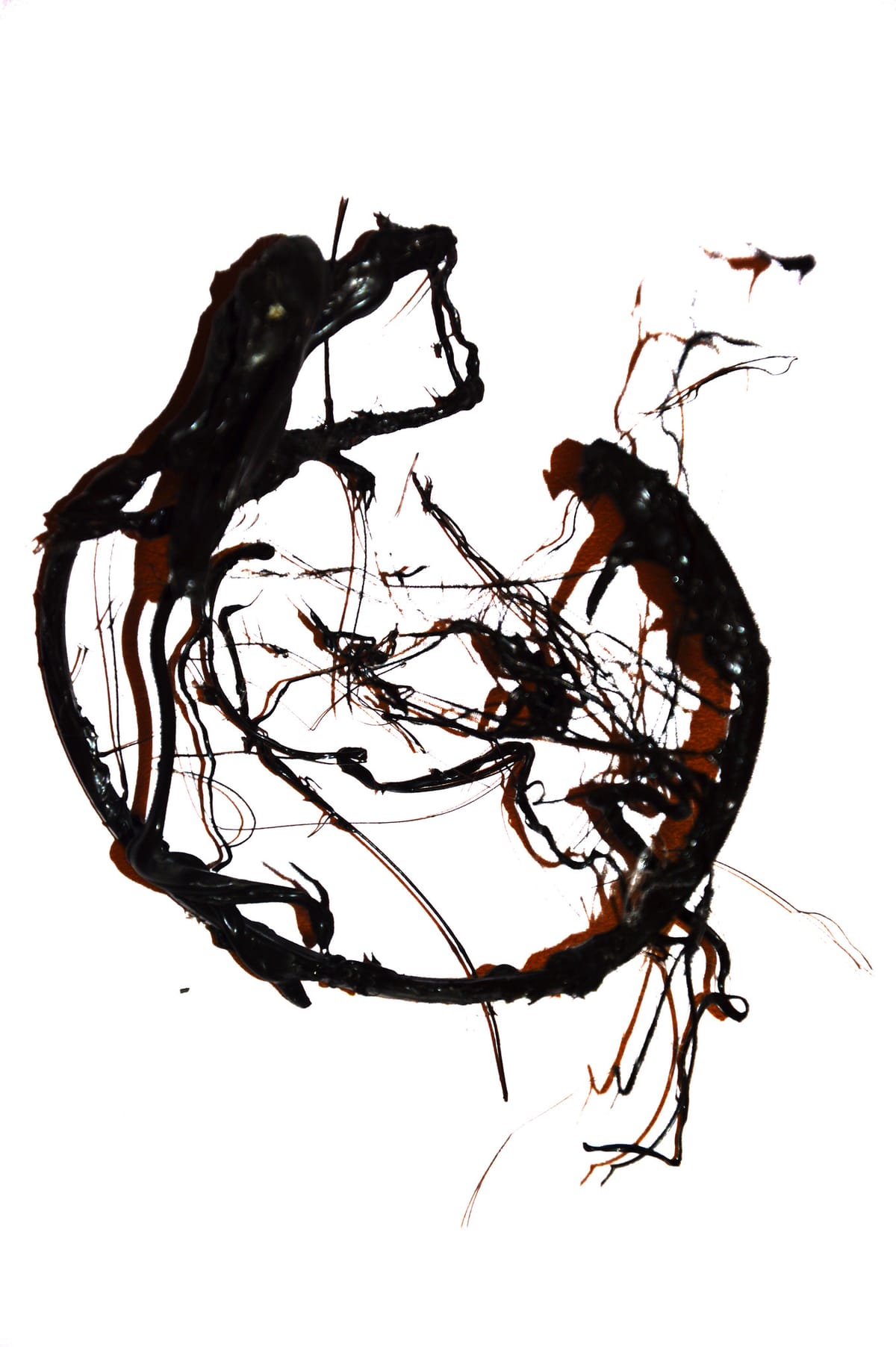Hype is a kind of currency in the tech world, and when so much of the market for innovation depends on speculation, all kinds of monsters appear. Vassilis Galanos theorises this hype as a form of capital.
by Vassilis Galanos
Two books have influenced me a lot since I was roughly a teenager, but I never had the opportunity to read them cover to cover. I now have had the pleasure to have nearly finished reading Capital by Karl Marx (with Friedrich Engels’ additions) and The Accursed Share by Georges Bataille. I was obviously biased to read the two in light of the research topics that interest me, technological hype being one of them, the historical sociology of the internet and artificial intelligence another. These notes serve as the culmination of thoughts I had while exploring the two three-volume books. Everyone is welcome to comment as this is an open-ended document.
I
Preliminaries
Hype, short for hyperbole [Greek for exaggeration], can be thought of as synonymous with anything relating to excess, surplus, or waste. I hereby argue that, in contemporary societies, hype – technological hype in particular – becomes a self-supporting force that attaches itself to the various economic-political transformations from capital to commodity to money. It can be thought of as a mediator standing between these transformations.
II
Hype as Mediator between Money and Commodity
Throughout the three volumes of The Capital, Marx coined a formulaic nomenclature about the transformations from money (capital) to commodity and vice versa that took the form of money-commodity-money (M-C-M). For Marx, the circulation of commodities adds value to the initial monetary (or capital) investment, resulting into surplus value, denoted as M-C-M’. I propose to think of hype as an additional mediator within such formulas; for example, money-hype-commodity-hype-money. The transformational process augments these initial elements that become inseparable from hype. Hype is overtaking the very existence of these forms, to the extent that contemporary exchanges involve transactions between hyped money (or hyped capital) and hyped commodity as investors largely depend on the hype surrounding them while products and services earn legitmacy through the hype circulating about their utilitarian or symbolic value. Hype mediation becomes so intense that it becomes increasingly harder to differentiate an object or a concept from the hype that mediates for it. I therefore suggest that we can perceive: (a) hype-as-capital: one is a legitimate investor if one is sufficiently hyped; (b) capital-as-hype: the more capital one owns, one is more likely to become hyped by controlling relevant means of circulation; (c) hype as commodity: often consumers are invited to purchase services that enable their visibility or hype; and (d) commodity as hype: often consumers buy something, or buy into something, because of the surrounding hype, without sufficient assessment of the need for the given offer. These four types of transformation are not entirely separate as they result from the increasing mediation of hype between monetary transactions and processes of commodification. Their in-between relationships offer a fertile ground for understanding the complexity of hype.
III
Hype as a Form of Currency and Advanced Capital
Technological hype functions as a de facto currency by representing perceived value shifts within the market, enabling transactions that rely on future innovation potential rather than present utility. Yet, as hype is not yet recognised by formal institutions (such as banks) as a quantifiable form of credit, a critical understanding of its processes is elusive and requires investigation. Hype acts as advanced capital by inflating the valuation of ventures and ideas beyond their immediate capacity, mobilising resources based on speculative future returns, akin to anticipatory capital formation. I project that if contemporary generative artificial intelligence large language models (LLMs) can perform in such and such way now, their performance in 10 years will be so and so; and therefore I legitimise investment in their research as well as rapid adoption of the product.
IV
Hype as Speculative Credit and Promissory Note
The enthusiasm surrounding technological advancements constitutes a form of speculative credit, where hype serves as a promissory note grounded in collective belief in future breakthroughs and returns. Hype creates a speculative economy dependent on fictitious promissory capital: imagined future wealth and satisfaction of desires. When the anticipated technologies do not deliver, this landscape is susceptible to collapse or replacement by new hype, revealing the transient nature of hype-driven markets. The main difference between previous rounds of speculative credit is that hype is not as of yet recognised as such. During early stages of the lockdown, hype about the metaverse (a desire for complete immersion into a virtual world) dominated, paired with speculations about potential permanence of lockdown measures or the constant threat of biological viruses. Companies had multiple speculative arguments to promote investment in metaverse models given the wider social context of users spending increasingly more screen time. Post-lockdown, the efforts were quickly stirred to computers acting as assistance, and hype quickly transitioned to artificial intelligence assistants that interfere with the analogue world, rather than humans entering the digital world. As speculative credit is based on assumptions, technological hype is also based on such; including assumptions about the separability between analogue and digital.

V
Hype as an Accelerator of Velocity Circulation and a Medium of Convertibility
In markets driven by technological hype, the rapid exchange of promises and expectations accelerates the velocity of exchange between money and value, as actors trade on the projected future rather than current material reality. As such, hype facilitates the convertibility between different forms of capital – financial, social, and symbolic – under the belief that current attention and discourse will translate into tangible economic benefits. The aforementioned example of rapid transitions between metaverse and artificial intelligence hype is relevant here – and is supported by the historicity of previous rounds of artificial intelligence excitement (in the 1960s and the 1980s) replaced by promises of virtual reality, total internetted connectivity, or cyborg enhancement across various decades. Technological hype offers sufficient room for rapid attention shifts: everytime machines are not good enough to be “friends” or “helpers,” they can become entire environments of the future or guarantee bodily modification for life extension; and once it is proven that they cannot live to these expectations, they present promises about their role as ideal assistants.
VI
Hype as a Form of Alienation from Product, Process, Others, and Self
Through its immense velocity and shift of centres of gravity, technological hype alienates consumers from the actual products, as attention is diverted from tangible utility and satisfaction towards the abstract promise of future innovation. Workers and developers experience alienation from the production process as the focus shifts from craftspersonship and process to meeting inflated expectations driven by market hype. In particular, companies like Meta and OpenAI exploit cheaper offshore labour to maintain their edge in innovation – such processes are deeply alienating in the façade of hyped presentation of technological output. Social relationships become mediated by hype, where connections and collaborations are increasingly dictated by perceived market potential rather than genuine human interaction or collaboration. Individuals working within hyped technological sectors may become alienated from their own identities and labour, as self-worth becomes tied to fluctuating market perceptions rather than personal fulfilment or achievement. I am hyped, therefore, I am.
VII
Hype as Speculative Spectacle and Spectacular Speculation
I am hyping, therefore, I become something other to those I treat as others. Hype acts as a spectacle between individuals, separating them but also attracting them towards the point of division. This concentration of attention is based on different apprehensions of speculation. Hype acts as a Rorschach inkblot where different groups or individuals project their own preferred or avoidable futures. It is thus a speculative spectacle. By so being, and due to its self-propelling characteristics, like capital, it feeds on itself, therefore becoming spectacular speculation – the more hyped a statement about a technological future is, the more valid the speculation appears to be. As digital technologies feed on their own historical hype, now counting more than seven decades, alliances are being formed in reaction to hype (governments, universities, industrial and military stakeholders may align their goals) while at the same time hype’s intensity generates sufficient separation between goals, largely denominated through terminological deviance: frontier artificial intelligence has different goals to usage of artificial intelligence in healthcare and border control facial recognition is seemingly separate from the selfie culture on social media.
VIII
Hype Sovereignty as the Locus of Commodification and Squandering
Technological hype transforms abstract innovation into commodified potential, where the anticipation of future wealth becomes a traded commodity itself, further entrenching commodification within cultural and economic discourse. Technological hype can then result in, or promote, the squandering of resources (particularly human, nonhuman animal and environmental resources), where capital, labour, and natural resources are allocated towards speculative projects. Hype creates a sacrificial economy where stakeholders willingly and ritualistically devote resources to the future potential of technologies. The high degrees of symbolism in hype processes resemble the ritualistic forms of expression of royal sovereignty of the past, where sacrifices and gifts were considered to be an expression of power that does not hesitate to squander the outcome of labour. Distribution of such symbolic energy through art and craft (precursors to contemporary meanings of “technology”) also implies the potential for appropriated or awakened sovereignty by the marginalised or the oppressed. The ability to use hype in the service of revolution through art and craft might be a valid approach to resistance, although it carries the caveat of recognising the value of hype as taken-for-granted, similar to the recognition of monetary bank notes, bullion, etc. Can forces of resistance use hype as a tool to disseminate the value of their position when this tool is proven to be largely constructed by and serving the interests of capitalism? The same question holds merit in the controversy between total abolitionists of technological infrastructures (primitivists or luddites refusing to engage with, or attempting total destruction of, capitalist technological artefacts) and participatory and inclusive approaches propose the seize of means of production and their redesign according to user needs, with antiexploitation principles. Can there be a case of seizing the means of hype production and circulation? Can there be a “healthier” version of hype?
IX
Hype and Luxury as Excess
Hyped technologies often resemble luxury items, valued for their symbolic status rather than practical utility. It is a form of luxury for something to be “hyped” (or even to be valued as “non-hyped”) and to be hyped is a form of luxurious recognition, an immaterial investment with material foundations, building on the excess energy of promise. This results in cycles of wasteful expenditure, highlighting the allure of the new over meaningful outcomes. Although semantic, symbolic, and linguistic in its main form, hype-driven excess materialises in surplus that takes the form of waste and undervalued labour, as in the case of e-waste management sites where informal child labour is still considered contextually appropriate. An additional note on luxuries that are valued as “non-hyped”: within hype-saturated environments, for example in the online sphere, there often is tendency for “counter-hype” – strong arguments against the hype (the phrase “don’t believe the hype” has become commonplace). A recent example can be found in the wide circulation of handheld consoles emulating vintage videogames; by default their hype is claimed through “non-hyped” elements: no need for Wi-Fi or any internet connection, and their selling point is the appreciation of the “old” rather than the “new” (as opposed to the selling of “novelties” that will offer financial or symbolic returns in the future). By not playing by the rules of standard hype, they create hype about non-hype; they confirm the hype game’s rules by negating them, and thus add dimensions to hype processes.
X
The Peculiar Dialectic between Accumulation and Non-Accumulation of Hype, or, Hype Reproduction
Hype, being chiefly linguistic and semantic does not accumulate materially as various forms of fixed capital. However, viewed psychically, it accumulates in the form of desires and expectations, thus leading to its eventual dissipation through various forms of hype exchange and circulation that can be studied as part of political and economic processes. This can be termed spatiotemporal hype reproduction through expansion and contraction of hype across domains and generations. Hype expansion (generalised enthusiasm about a technological potential) and hype contraction (generalised disillusionment about it) can correlate with periods of financial wealth or stagnation, however in reverse relation: periods of hype disillusionment correlate with periods of money stagnation where hype in a certain area is assessed and evaluated by practical outcomes; then transferred from domain a (e.g. artificial intelligence) to domain b (e.g. virtual reality) as an exchange of promissory notes towards economic prosperity – if guaranteed income was not satisfied by investing in this domain, then that domain will fulfil the prophecy. Hype also transfers intergenerationally through cycles of hype expansion and contraction across domains, taking into account the generational loss of historical memory (e.g. the many different rounds of digital technological hype). This liquid form of hype as advanced capital correlates to the introduction of economic crisis through disillusionment but also wealthiness through temporary alliances to fulfil hype prophecies. This macro-apprehension of hype as collective history and as domain movement corresponds with technological hype seeking to fulfil personal desires for covering basic needs, achievement, status, symbolic and material property, and further satisfaction, serving as a psychological outlet at the micro or individual level. This propels the constant participation in hype production, circulation, and criticism (in favour of alternative hype).
XI
Primitive Accumulation and Hype
Processes of primitive accumulation can be found through the historical study of hype. The primitive accumulation of data taking place during the Web 2.0 hype at the beginning of the century (the belief that the web could become a global village or bottom-up, democratically shaped virtual space) resulted initially in critical counter-hype about that data being wasteful due to their excessive nature (e.g. millions of pictures of the same big city monuments) or even harmful (e.g. when personal information online may result in stigma or other undesired outcomes, leading to the ‘right to be forgotten’). However, the study of pattern associations between such informational content and its metadata (who took the picture, when, why), resulted in the revival of machine learning algorithms that were dismissed as futile in the 1970s. Prior knowledge about these algorithms’ potential paired with hype about online communities as a technology-mediated liberating force resulted in the appropriation of voluntary labour during leisure or free education time for eventual monetary gain through the attention economy that employed these data accumulated in the “primitive” period of Web 2.0 for personalised advertisement in the 2010s (including for reasons of voting behaviour manipulation) and generative artificial intelligence in the 2020s. This was capital’s methodic capture of actions conducted by hackers, online activists, and virtual communities at large, that transformed their contributions into unpaid labour (surplus value), turning their desires against them through strategic processes of hype. Revolutionary potential through the seizure of means of production was transformed, through various waves of hype, into the raw material for production of new means of production (from community-driven data to generative artificial intelligence training datasets).
Bibliography
Bataille, G. (1988). The Accursed Share. Vol. I. (Trans. Robert Hurley). New York: Zone.
Bataille, G. (1991). The Accursed Share. Vols. II and III. (Trans. Robert Hurley). New York: Zone.
Marx, K. (2013). Capital: A critical analysis of capitalist production (Trans. S. Moore, E. Aveling, & E. Untermann). Wordsworth.
Marx, K. (1966). Capital: A Critique of Political Economy Volume III: The Process of Capitalist Production as a Whole. Edited by Friedrich Engels. (Trans. Institute of Marxism-Leninism). Moscow: Progress Publishers.
Acknowledgement: I would like to thank Ola Michalec and Sam Button for generous feedback on this piece.
Vassilis Galanos (sometimes known as onesecafterthelaughter) is Lecturer in Digital Work at the University of Stirling, exploring issues of hype, expectations, and expertise in the history and sociology of artificial intelligence and the internet, also interested in the political economy of AI in casualised Higher Education and Research. Vassilis is also a rapper, DJ, photographer, and misses periods of backpacking and hitchhiking. Prefers to abstain from meat and pronouns.
Vassilis has co-initiated the transnational and transdisciplinary Hype Studies group, interrogating hype from multiple critical perspectives: https://hypestudies.org/






Comments ()